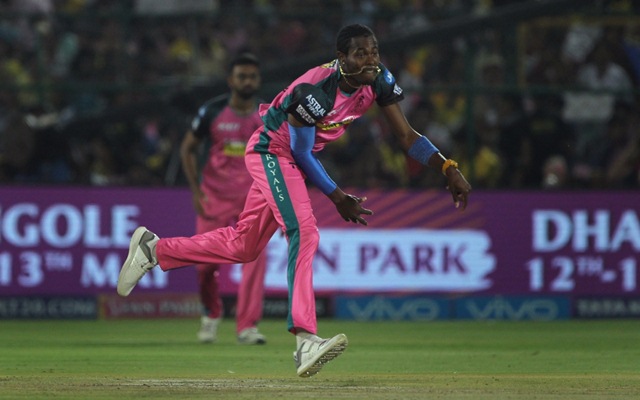How does Jofra Archer generate all that pace?
It is Archer's pace that makes him a stand out bowler and his action that keeps him in good stead.
View : 2.8K
2 Min Read


England’s Jofra Archer is one of those bowlers from this current generation who can consistently bowl above 145kmph without putting a lot of strain on his body. He has a smooth action and bowl with a lot of accuracy. To be able to consistently deliver at that pace and with such precision in the long-run takes a lot more than what meets the eye. At the same time, he doesn’t seem to be an injury-prone bowler.
To understand that in detail, let us divide his bowling into six parts:
Run-up
Approach to the crease
Jump
Back Foot Contact
Front Foot Landing
Follow Through
1. Run-up
Archer has a pretty easy and a really smooth run-up. He starts his run-up by slightly bending his back, which allows him to keep his body weight on the front foot and create a launch pad like position for himself.
2. Approach to the crease
After getting a bit of momentum, Archer becomes upright and sets himself up. His arm and foot alignment is very well coordinated, and it looks like he is just jogging towards the crease, but on the contrary, that is the really crucial as the hand and foot alignment determines how good is the rhythm is and the rhythm, in turn, dictates how strongly one is able to deliver the ball.
3. Jump
Archer doesn’t have a jump like Brett Lee or Waqar Younis and many other great fast bowlers who landed at the crease with that momentum. Archer does jump which can even go unnoticed, and this is the main reason why he is not injury prone. Most bowlers certainly want to implement this but do not succeed because their bowling action doesn’t allow them to be able to do so.
E.g., Mark Wood. He has a big jump towards the crease, which makes him injury prone; that of course if not managed properly.
Also read – 10 Indian cricketers’ wives and their professions
4. Back foot contact
Before the delivery stride, it is essential for a fast bowler to make strong back foot contact because that transfers the whole momentum, onto the front foot. Archer doesn’t land his entire foot on the ground, because it would then absorb the whole force and will reduce the pace the can put behind the ball. So to bowl faster, the strength in the ankle of his back leg is essential.
5. Front foot landing
This is probably the most important element a fast bowler needs to work on. This is the point where most bowlers tend to injure themselves. After the jump and the back foot contact, the front leg takes 6-7 times the pressure of the body weight. Usually when the bowler creates an angle with a bent knee, it puts pressure on that part of the body and we often see fast bowlers struggle with knee injuries due to that force. Archer is able to prevent that and also contributes to his pace.
6. Follow through

After delivering the ball, its job not done, a fast bowler’s follow-through also needs to be worked upon. Because the body releases all the pressure and if the follow-through is not in proper alignment, then chances of injuries are also high. But Archer has probably one of the best follow-throughs, because of his high and straight arm bowling action.
The whole pressure and the momentum of the body are released. Keeping the head still during the release and follow-through is another crucial aspect, and Jofra Archer at this point seems to be pretty much in sync in almost every aspect a fast bowler needs to work on.
Here is a video of Archer’s bowling:
~ Written by Amey Kulkarni
Download Our App